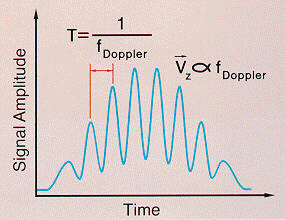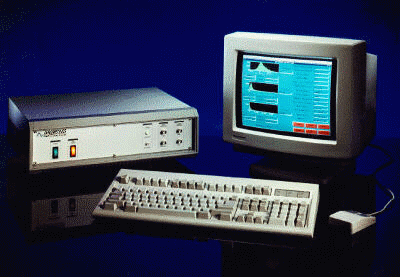


Crossed beams showing interference fringes

Doppler pulse obtained from light scattered by particle
Because the fluid velocity is inferred from these naturally occuring or introduced particles, the particles must be small enough to follow the flow field accelerations, yet large enough to scatter sufficient light intensity. Optimum particle size is generally between 0.5 and 2 micrometers. Aerometrics LDV systems can be supplied with a particle size discriminator circuit which insures that only particles of a desired size are included during data acquisition.
Very small probe volumes can provide highly resolved velocity profiles and allow measurements close to a wall or object in the flow. Simultaneous dynamic measurements can be made in two or three dimensions for full turbulence analysis. Successful measurements have been made in harsh environments including under water, in combustion processes, and in explosions.
Frequency shifting applied to the input beams acts to offset the Doppler frequency, providing improved dynamic range and allowing distinctions between forward and reverse flow directions. The transmitter implements frequency shifting via a Bragg cell, giving a fixed frequency shift of 40 or 80 MHz, for high velocity or high turbulence measurements.
With two or three component systems, several wavelengths are used to form independent overlapping probes for orthogonal flow directions. This greatly reduces the time required for mapping multi-dimensional flows.
Aerometrics optical systems provide superior alignment stability and are designed to virtually eliminate the need for internal adjustments. The standard optical transmitter is rugged and easy to set up. Selectable beam spacings, beam expansion, and interchangeable focusing lenses provide a combination of fringe spacings and probe volume sizes to accommodate a wide range of flow conditions.

Aerometrics' Real-time Signal Analyzer LDV / PDPA analysis system and
software
Aerometrics has developed a unique method to directly measure the sample volume simultaneously with respect to particle size and velocity. This enables an accurate determination of the particle number density and volume flux. The Phase Doppler method requires no calibration because the measured particle size and velocity are dependent only on the laser wavelength and optical configuration. PDPA measurements are not based on light intensity, and consequently are not subject to errors from beam attenuationor deflection which occur in dense particle and combustion environments.